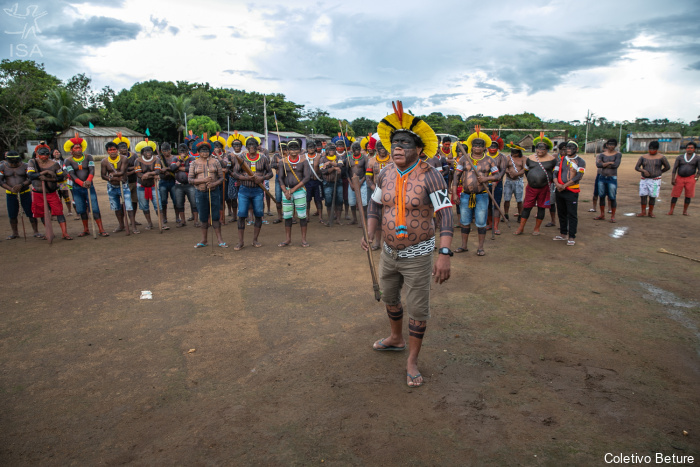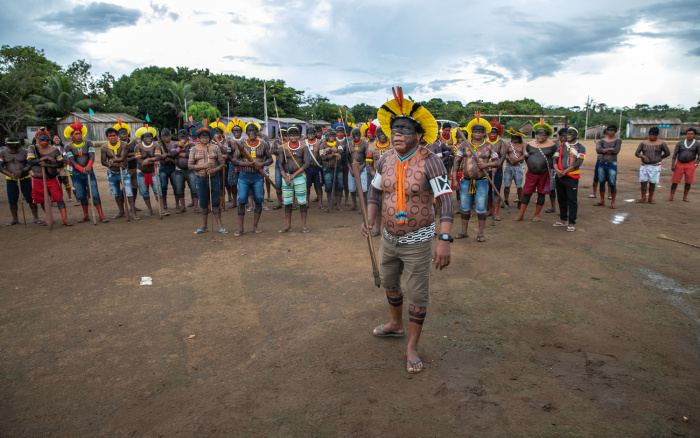Você está na versão anterior do website do ISA
Atenção
Essa é a versão antiga do site do ISA que ficou no ar até março de 2022. As informações institucionais aqui contidas podem estar desatualizadas. Acesse https://www.socioambiental.org para a versão atual.
Under Bolsonaro, illegal mining in the Kayapó Indigenous Land has exceeded by 30% the total destroyed in the last 40 years
sexta-feira, 07 de Maio de 2021 
Illegal mining advances with impunity in the Xingu
Esta notícia está associada ao Programa:
In manifest, 60 villages of the Kayapó people repudiate a bill that intends to legalize mining in their territories; more than 5,700 illegal mining outbreaks were detected between 2018 and 2020 in Indigenous Lands and Conservation Units in the Xingu basin
“I don't want them to end up with my land and water. We just want our forest standing so that our grandchildren can survive ”, asks a menire, a woman from the Kayapó people, in a manifesto recorded by 60 villages in repudiation of the advance of illegal mining in their territories. Gathered in the village Kriny, Kayapó Indigenous Land (PA), the indigenous people ask for the archiving of bills that intend to legalize the mining.
Between 2018 and 2020, a period that coincides with Bolsonaro's campaign and mandate, deforestation in the Kayapó IL due to mining has already exceeded 31% of the total deforested in almost 40 years - between 1980 and 2017. “We are in constant struggle for our survival and to remain who we are. We are not going to give up our lands for false promises coming from the Bolsonaro government”, warn the Kayapó. [Read the full letter in Portuguese and the English version]
More than 4.7 thousand hectares of gold mining were registered in just 3 years, between 2018 and 2020. The rate continued to rise in the first two months of the year 2021, when 256 hectares were deforested in the Kayapó IL, 18% more than January and February 2020.
In addition to the Kayapó IL, the mobilization included indigenous people from the Menkragnoti, Las Casas and Baú ILs, representing a population of approximately 6,500 people.
Watch the video with Portuguese subtitles
The data are from the 23rd Sirad X report, the deforestation monitoring system of the Xingu + Network, an articulation of indigenous, riverine and civil society organizations for the defense of the rights of the Xingu peoples.
“With multiple land access routes to the IL, dozens of machines, hundreds of prospectors and gold mining sites spread over a huge territory, continuous and permanent actions are needed, since the offenders, motivated by the financial return of gold, return shortly after the departure of the enforcement teams”, says the text.
Illegal mining advances with impunity in the Xingu
A new wave of illegal mining threatens Protected Areas in the Xingu basin. From 2018 and throughout 2019, gold mining areas were opened or reactivated in three Indigenous Lands and four Conservation Units. [Learn more: “Dossiê garimpo no Xingu”]
Illegal mining has gained strength in new regions, re-activating areas that were closed for more than 14 years, such as the Resex Riozinho do Anfrísio, in Pará. In addition to Riozinho do Anfrísio and the Kayapó IL, which lead the rank in illegal mining in Xingu, this activity also intensified in the Trincheira Bacajá, Baú, Apyterewa and Cachoeira Seca ILs, in the Altamira National Forest (Flona), in the Serra do Pardo National Park and in the Resex Iriri.
In the first two months of 2021, 287 hectares of gold mining were detected in the Indigenous Lands and Conservation Units of the Xingu, putting the health of indigenous peoples and traditional populations at risk.
Between January and February this year, 13 hectares were detected in the mining area located in the Trincheira Bacajá Indigenous Land, Xikrin territory, and 4 hectares in two mining sites in the Apyterewa Indigenous Land, Parakanã territory. The two territories are also facing the advance of land grabbing in their territories. [Find out more in the special “Xingu under Bolsonaro”]
“If, on one hand, the high price of gold in the international market supports this activity of strong risk and which implies enormous social and environmental losses, on the other, the total lack of control over the gold’s chain of custody in Brazil serves as an incentive”, says the report.

Isabel Harari
ISA
Imagens:
Arquivos:
| Anexo | Tamanho |
|---|---|
| 21.99 MB | |
| 88.4 KB |


